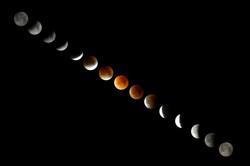Glossary term: Eclipse
Description: An eclipse occurs when an astronomical object is temporarily obscured by either passing into the shadow of another body or when another body passes between the viewer and the object. Examples for eclipses are lunar eclipses when the Earth stands between the Sun and the Moon and the Moon moves into the Earth´s shadow, or solar eclipses, when the Moon moves between the Earth and the Sun and blocks part or all of the Sun´s light. If the obscuring body only obscures a small part of other body, this phenomenon is called a transit. If the obscuring body completely obscures the other body, this phenomenon is called an occultation
Related Terms:
See this term in other languages
Term and definition status: This term and its definition have been approved by a research astronomer and a teacher
The OAE Multilingual Glossary is a project of the IAU Office of Astronomy for Education (OAE) in collaboration with the IAU Office of Astronomy Outreach (OAO). The terms and definitions were chosen, written and reviewed by a collective effort from the OAE, the OAE Centers and Nodes, the OAE National Astronomy Education Coordinators (NAECs) and other volunteers. You can find a full list of credits here. All glossary terms and their definitions are released under a Creative Commons CC BY-4.0 license and should be credited to "IAU OAE".
If you notice a factual error in this glossary definition then please get in touch.
Related Media
The Eclipse Between Us, by Muhammad Rayhan, Indonesia
Credit: Muhammad Rayhan/IAU OAE
License: CC-BY-4.0 Creative Commons Attribution 4.0 International (CC BY 4.0) icons
Red Moon, by Daniel Henrion, France
Credit: Daniel Henrion/IAU OAE
License: CC-BY-4.0 Creative Commons Attribution 4.0 International (CC BY 4.0) icons










